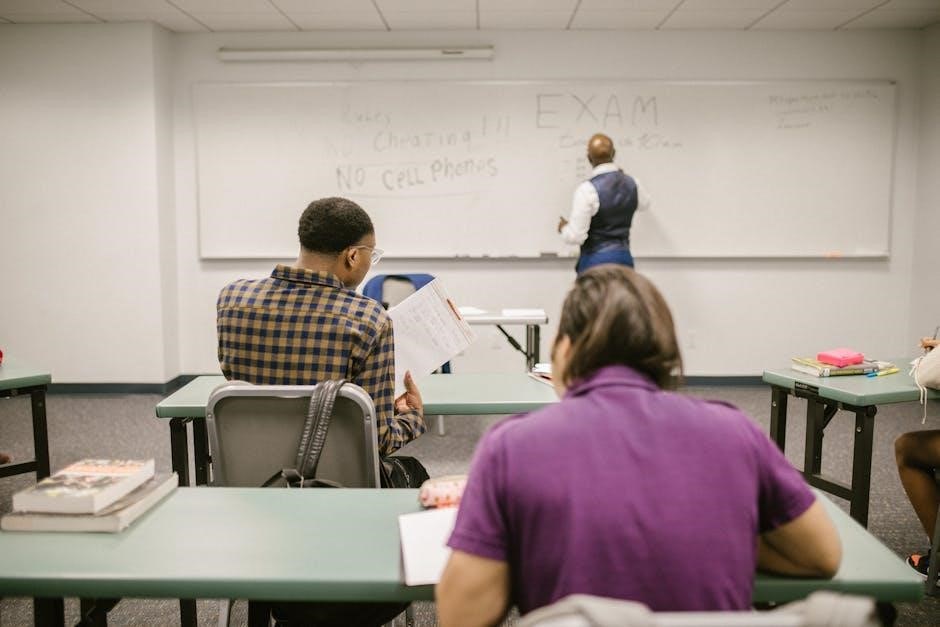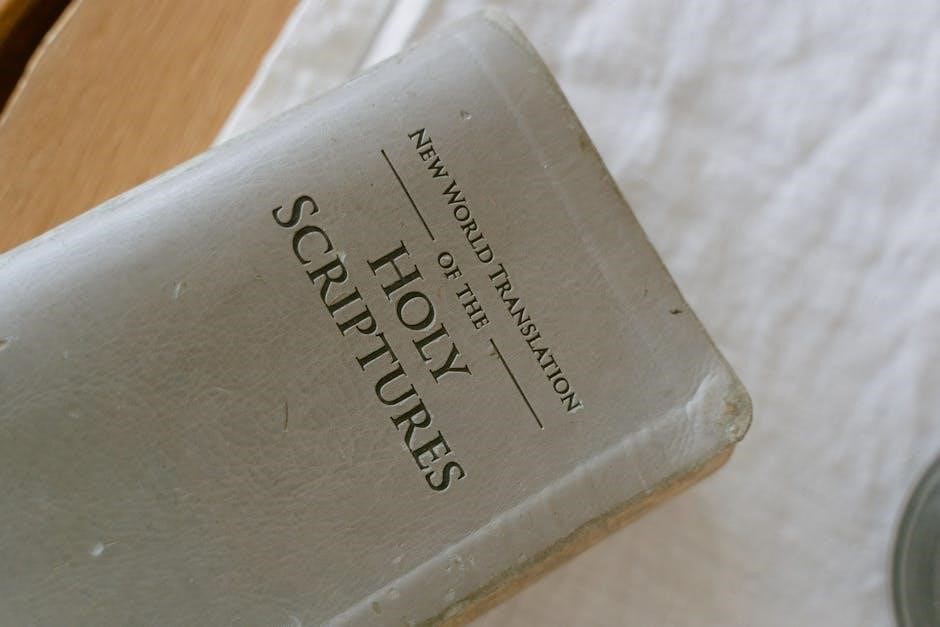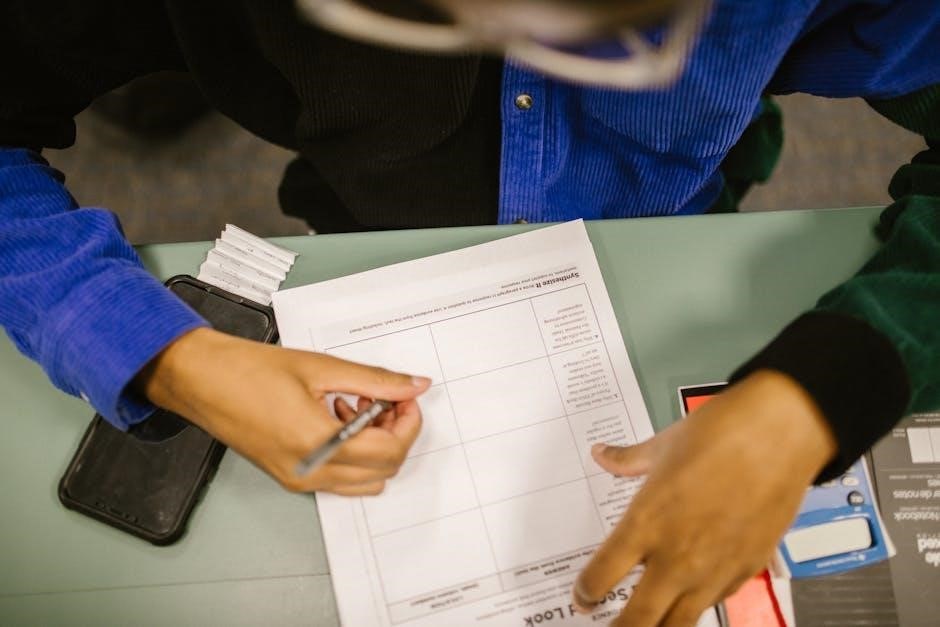The NY Motorcycle Permit Test is essential for ensuring safe and legal riding. It covers traffic laws, road signs, and safe practices, with the manual and practice tests being key resources.
Overview of the Motorcycle Permit Test
The NY Motorcycle Permit Test evaluates knowledge of road safety, traffic laws, and motorcycle-specific rules. It features 20 multiple-choice questions, requiring at least 14 correct answers to pass. Topics include road signs, safe riding practices, and motorcycle operation. The test is based on the New York State Motorcycle Operators Manual, which covers essential information for riders. Preparation is key, with practice tests and study guides available online to help applicants master the material and ensure success on the exam. Proper preparation enhances safety and confidence for new riders.
Importance of Preparation
Preparation is crucial for success on the NY Motorcycle Permit Test. Thorough study of the manual ensures familiarity with traffic laws and safety practices, reducing risks on the road. Practice tests help identify weak areas, allowing focused learning. Understanding road signs and motorcycle-specific rules enhances confidence and readiness. Adequate preparation not only improves test scores but also fosters safer riding habits, benefiting both the rider and other road users. It is essential for applicants to dedicate time to studying and practicing to achieve the best outcomes.

Eligibility Requirements for the NY Motorcycle Permit
To qualify for a NY motorcycle permit, applicants must meet specific criteria, including age requirements, providing proper documentation, and passing a vision test. Additional requirements apply for minors.
Age Requirements
In New York, applicants for a motorcycle permit must be at least 16 years old. Riders under 18 are required to complete an approved motorcycle safety course. Those under 16 cannot apply for a motorcycle permit. A valid Class D driver’s license is also necessary for eligibility. Minors must provide parental consent, and all applicants must meet vision and documentation standards set by the NYSDMV. These age requirements ensure that riders have the necessary maturity and skills to operate a motorcycle safely on public roads.
Documentation Needed
To apply for a New York motorcycle permit, specific documents are required. These include proof of identity, such as a valid passport or birth certificate, and Social Security verification, like a Social Security card. Additionally, applicants must provide proof of residency in New York State, which can be demonstrated through a utility bill or bank statement. Minors under 18 need a signed parental consent form. All documents must be original or certified copies. Ensuring all paperwork is in order simplifies the application process and avoids delays.
Vision Test Requirements
A vision test is mandatory for obtaining a New York motorcycle permit. Applicants must demonstrate visual acuity of 20/40 in both eyes, with or without corrective lenses, and have a horizontal field of vision of at least 140 degrees. If wearing glasses or contacts, bring them to the test. Those with vision worse than 20/40 may be restricted to daytime driving only. Failing to meet these standards could result in permit denial or specific restrictions. Ensuring good vision is critical for safe motorcycle operation.

Understanding the New York Motorcycle Permit Test Format
The test consists of 20 multiple-choice questions on traffic laws, road signs, and safe riding practices. Studying the manual ensures familiarity with the exam structure and content.
Written Test Structure
The NY motorcycle permit written test features 20 multiple-choice questions, covering topics like traffic laws, road signs, and safe riding practices. To pass, you must answer at least 14 correctly. The format mirrors real DMV tests, ensuring familiarity. Questions are designed to assess your understanding of motorcycle-specific rules and safety guidelines. Studying the New York State Motorcycle Operators Manual is crucial, as it provides detailed information on all test topics. Practice tests are also available online to help you prepare effectively and identify areas for improvement.
Road Signs and Traffic Laws
Road signs and traffic laws are critical components of the NY motorcycle permit test. The exam includes questions on regulatory signs, such as speed limits and stop signs, as well as warning signs like curves and pedestrian crossings. Motorcycle-specific laws, like helmet requirements and lane-sharing rules, are also emphasized. Familiarizing yourself with these signs and laws through the New York State Motorcycle Operators Manual and online practice tests ensures better preparation and safer riding practices.
Safe Riding Practices
Safe riding practices are a cornerstone of the NY motorcycle permit test. The exam emphasizes strategies to maintain control of your bike, such as adjusting speed according to road conditions and using brakes effectively. Wearing protective gear, including helmets and gloves, is also stressed. Topics like following distance, the “two-second rule,” and proper lane positioning are covered to reduce accident risks. Understanding these practices ensures riders can navigate roads safely and responsibly, making them a key focus of study in the New York State Motorcycle Operators Manual.

The New York State Motorcycle Operators Manual
The New York State Motorcycle Operators Manual is a comprehensive guide for motorcycle riders. Available online from the DMV, it covers road signs, traffic laws, and safe riding practices.
Key Sections of the Manual
The New York State Motorcycle Operators Manual includes vital sections such as road signs, traffic laws, and safe riding techniques. These sections are crucial for understanding motorcycle-specific rules and ensuring safety on the road. The manual also covers emergency maneuvers and special riding situations, like night riding and inclement weather. By focusing on these key areas, riders can prepare effectively for the NY Motorcycle Permit Test and develop essential skills for safe motorcycling in New York.
How to Use the Manual Effectively
To use the New York State Motorcycle Operators Manual effectively, read it thoroughly and take notes on key sections. Focus on road signs, traffic laws, and safe riding practices. Review diagrams and examples to better understand concepts. Practice with online tests to reinforce your knowledge. Highlight important pages and create flashcards for difficult topics. Dedicate time to study regularly, ensuring you master all areas before taking the permit test. This structured approach will help you prepare confidently for the exam and become a safe, informed rider.

Essential Topics to Study for the Permit Test
Master motorcycle safety tips, traffic laws, and lane positioning. Understanding these is crucial for safe riding and passing the New York motorcycle permit test with confidence.
Motorcycle Safety Tips
Motorcycle safety tips are crucial for reducing risks on the road. Always wear protective gear, including a helmet, gloves, and durable clothing. Ensure your bike is in good condition before riding. Be visible by wearing bright clothing and using headlights. Maintain a safe distance from other vehicles and avoid hazards. Never ride while fatigued or distracted. Practice defensive driving and stay alert to surrounding traffic. Regularly check your speed and position to maintain control. Familiarize yourself with emergency maneuvers and know how to handle sudden stops or skids. Stay informed about road conditions and weather to adjust your riding style accordingly.
Traffic Laws Specific to Motorcycles
Traffic laws for motorcyclists in New York emphasize safety and visibility. Riders must wear DOT-approved helmets and follow all traffic signals and signs. Lane splitting is illegal, and motorcyclists must use designated lanes. The headlight must be on at all times, and passengers are only allowed if the bike is equipped with a passenger seat and footrests. Motorcyclists must maintain a safe distance from other vehicles and avoid reckless maneuvers. Familiarize yourself with these laws to ensure compliance and safety on the road.
Lane Positioning and Group Riding
Lane positioning is critical for visibility and safety. Motorcyclists should ride in the left or right third of the lane to avoid blind spots. Avoid weaving between lanes or tailgating. When riding in groups, use a staggered formation, with each rider offset from the one in front. This creates space for reaction time and emergency maneuvers. Communicate with hand signals, and maintain a safe distance from other riders. Group riding requires coordination and awareness to ensure everyone’s safety on the road. Always follow traffic laws and stay vigilant.
Special Riding Situations
Special riding situations require extra caution, such as navigating inclement weather, night riding, or emergencies. Stay alert, maintain safe distances, and be prepared for unexpected challenges on the road.
Riding in Inclement Weather
Riding in inclement weather demands heightened vigilance and caution. Rain, fog, or snow significantly reduce visibility and traction. Motorcyclists should slow down, increase following distances, and avoid sudden maneuvers. Use appropriate gear like rain suits and ensure tires are suitable for wet conditions. If weather conditions worsen, consider stopping until it improves. Always maintain a defensive riding posture and be aware of road hazards that may be exacerbated by poor weather. Stay alert and prioritize safety above all else.
Night Riding Safety
Night riding requires extra caution due to reduced visibility and increased risks. Motorcyclists should wear reflective gear and ensure all lights are functioning properly. Slow down and increase following distances to compensate for limited visibility. Be aware of potential hazards like pedestrians or debris that may be harder to spot at night. Use high beams when possible but dim them for oncoming traffic. Stay alert for fatigue and avoid distractions. Consider reducing speed in areas with poor lighting or heavy traffic. Always be prepared for unexpected situations and maintain a defensive riding posture.
Emergency Maneuvers
Mastering emergency maneuvers is crucial for motorcyclists to handle unexpected situations safely. Key techniques include swerving, hard braking, and controlled skids. Swerving requires quick, precise steering to avoid obstacles while maintaining balance. Hard braking involves applying both brakes firmly but controlled to prevent locking wheels. Skid control demands reducing speed and adjusting weight distribution to regain traction. Practice these maneuvers in a safe, open area to build muscle memory and confidence; Understanding when and how to execute them can prevent accidents and save lives on the road.

Understanding Road Signs and Signals
Recognizing road signs and signals is vital for safe motorcycling. They guide riders through traffic, indicate hazards, and ensure compliance with traffic laws, enhancing overall safety.
Types of Traffic Signs
Traffic signs are categorized into regulatory, warning, and informational types. Regulatory signs, like stop signs, enforce traffic laws. Warning signs, such as curve ahead or pedestrian crossings, alert riders to potential hazards. Informational signs provide guidance, like direction or service indicators. Recognizing these signs is crucial for safe riding and passing the NY motorcycle permit test. Understanding their shapes, colors, and meanings helps motorcyclists navigate roads effectively and adhere to traffic rules. Familiarity with these signs enhances safety and ensures compliance with New York’s traffic regulations.
Hand Signals for Motorcyclists
Hand signals are vital for motorcyclists to communicate with other riders and drivers. Common signals include extending the left arm straight out for a left turn, bending the left arm downward for a right turn, and pointing the left arm downward with a closed fist to indicate slowing or stopping. In group rides, signals like tapping the top of the helmet or waving the arm backward help coordinate actions. These signals enhance visibility and safety, ensuring clear communication on the road. Mastering hand signals is essential for safe and coordinated riding in New York.
Interpreting Road Markings
Understanding road markings is critical for safe motorcycle operation. Solid lines indicate boundaries between lanes or shoulders, while dashed lines suggest areas where passing is permitted. Arrows guide traffic flow, and symbols like the motorcycle icon signal shared lanes. Yellow lines separate opposing traffic, and white lines mark travel lanes. Curved arrows may indicate turns or merges. Motorcycle-specific markings, such as shared-lane arrows, help riders position themselves safely. Familiarizing yourself with these markings ensures compliance with traffic laws and enhances road safety. Study the NY Motorcycle Manual and practice tests to master these essential visual cues.

Motorcycle-Specific Laws in New York
New York enforces strict motorcycle laws to ensure rider safety and responsible road behavior. These laws cover equipment requirements, passenger restrictions, and mandatory insurance coverage for motorcyclists.
Helmet and Protective Gear Requirements
In New York, motorcyclists are legally required to wear a U.S. Department of Transportation (DOT)-approved helmet. Additionally, protective gear such as gloves, boots, and eye protection is strongly recommended to enhance safety. Riders under 21 must wear protective gear as part of the state’s safety regulations. These laws are enforced to reduce the risk of injury in the event of an accident. Compliance with these requirements is essential for both legal and safety reasons, ensuring a safer riding experience on New York roads.
Passenger Laws
In New York, motorcyclists carrying passengers must ensure the bike is equipped with a passenger seat and footrests. Passengers under 5 years old are prohibited unless in a sidecar. All passengers must wear a DOT-approved helmet. Motorcyclists must hold a valid Class M or MJ license to carry passengers. Riders with a learner’s permit are restricted from carrying passengers until they have held the permit for a specific period. These laws aim to enhance safety and reduce risks for both operators and passengers on New York roads.
Insurance Requirements
In New York, motorcyclists must carry liability insurance to cover damages or injuries caused to others. The minimum coverage includes $25,000 for bodily injury per person, $50,000 per accident, and $10,000 for property damage. Additional coverage, such as collision or comprehensive, is optional but recommended. Riders must provide proof of insurance when registering their motorcycle or renewing a license. New York operates under a no-fault insurance system, meaning your insurer covers your injuries regardless of fault. Failing to maintain proper insurance can result in fines, license suspension, or even motorcycle impoundment.

Preparing for the Written Test
Study the NY Motorcycle Operators Manual thoroughly, focusing on traffic laws and safe riding practices. Take online practice tests to familiarize yourself with the exam format and content.
Effective Study Strategies
Effective preparation for the NY motorcycle permit test involves consistent study and targeted strategies. Start by thoroughly reviewing the New York State Motorcycle Operators Manual, focusing on key topics like road signs, traffic laws, and safe riding practices. Utilize online resources, such as practice tests, to familiarize yourself with the exam format and identify areas needing improvement. Create flashcards to memorize important terms and concepts. Dedicate time each day to review material, ensuring a comprehensive understanding. Additionally, simulate test conditions by setting timers and avoiding distractions to build confidence and time management skills. Consistent effort will lead to a high score.
Practice Tests and Resources
Utilizing practice tests and resources is crucial for mastering the NY motorcycle permit test. The New York State Motorcycle Operators Manual is a primary resource, offering detailed insights into traffic laws, road signs, and safety tips. Online platforms provide free practice tests, mimicking the actual exam format, to help assess readiness. Websites like DMV-Written-Test and Drivetestacademy offer realistic questions and study guides tailored to New York’s specific requirements. Additionally, interactive tools such as flashcards and video tutorials can enhance learning. Regularly practicing with these resources ensures confidence and familiarity with the test content.
Time Management Tips
Effective time management is key when preparing for the NY motorcycle permit test. Allocate specific study times daily, focusing on challenging topics first. Use practice tests to simulate exam conditions, ensuring you complete them within the allotted time. Prioritize reviewing incorrect answers to improve weak areas. Break study sessions into manageable intervals to maintain focus and retention. By adhering to a structured schedule, you can efficiently cover all topics, enhancing your readiness and confidence for the test.

Motorcycle Safety and Maintenance
Regular inspections, proper tire pressure, and clean oil are crucial for safe riding. Maintain your bike to ensure reliability and performance on the road.
Pre-Ride Checks
Before starting your motorcycle, perform essential pre-ride checks to ensure safety. Inspect tires for proper pressure and wear, check oil and coolant levels, and test brakes. Verify that all lights, signals, and mirrors are functioning correctly. Ensure the chain or belt is properly tensioned and lubricated. Check for any fluid leaks or loose parts. Wearing protective gear, including a helmet and gloves, is also crucial. A thorough pre-ride inspection helps prevent mechanical issues and enhances your safety on the road.
Regular Maintenance Tips
Regular maintenance is crucial for ensuring your motorcycle runs safely and efficiently. Change the oil every 2,500 to 5,000 miles, depending on your bike’s specifications. Check and maintain proper tire pressure, as under-inflated tires can lead to poor handling and reduced fuel efficiency. Inspect and clean the air filter regularly, and replace it when necessary. Lubricate the chain or belt drive and adjust its tension to prevent wear. Replace brake pads when worn down to ensure reliable stopping power. Finally, check the battery terminals for corrosion and keep fluids, such as coolant and brake fluid, at recommended levels.
Protective Gear Recommendations
Wearing proper protective gear is essential for motorcycle safety. A DOT- or SNELL-certified helmet is mandatory in New York and should fit snugly. Durable gloves with grip and palm padding protect hands, while sturdy, ankle-high boots provide ankle support. A jacket and pants made of abrasion-resistant materials, such as leather or Kevlar, help prevent road rash. Consider gear with built-in armor for added protection. Additionally, wear eye protection, such as goggles or a face shield, to safeguard against debris. Always ensure gear fits properly and is free from damage to maximize safety while riding.

Common Mistakes to Avoid
Common errors include insufficient study of road signs, ignoring traffic laws, and poor time management during the test. Thorough preparation and practice can help mitigate these issues.
Test-Taking Errors
Common test-taking errors include rushing through questions, not thoroughly studying the manual, and misunderstanding traffic laws. Many applicants fail due to poor time management or neglecting to review road signs. To avoid these mistakes, practice with realistic exams and focus on weak areas. Misinterpreting motorcycle-specific laws, such as lane positioning and safety gear requirements, also leads to errors. Ensure you understand all traffic rules and signs before taking the test. Proper preparation and calm nerves are key to avoiding these pitfalls and achieving success.
Riding Mistakes to Avoid
Common riding mistakes include speeding, tailgating, and failing to use signals. Motorcyclists often overlook road markings and neglect to adjust speed in poor weather. Avoid weaving through lanes and always maintain a safe distance. Riding without protective gear is a critical error, as it increases injury risk. Additionally, failing to check mirrors and blind spots can lead to accidents. Proper lane positioning and anticipation of hazards are essential for safe riding. Avoiding these mistakes requires constant awareness and adherence to traffic laws.
Passing the NY motorcycle permit test requires dedication and thorough preparation. Use the manual and practice tests to build confidence. Stay focused, ride safely, and enjoy the journey ahead!
Staying Confident and Prepared
Confidence and preparation are key to acing the NY motorcycle permit test. Consistently study the manual, focus on weak areas, and take regular practice tests. Understanding road signs, traffic laws, and safe riding practices will boost your self-assurance. Visualize success, stay calm, and ensure you’re well-rested before the test. Familiarize yourself with the test format and time management strategies. Remember, preparation breeds confidence—stay focused, and you’ll be ready to succeed. Keep practicing, and your efforts will pay off on test day.
Next Steps After Passing the Test
After passing the NY motorcycle permit test, you’ll receive a learner’s permit, allowing supervised practice riding. Use this period to hone your skills and gain experience. Complete an approved motorcycle safety course if under 18, which is required before taking the road test. Schedule and pass the road test to obtain your full motorcycle license. Ensure you understand insurance and registration requirements to legally operate your bike. Stay updated on New York’s motorcycle laws and continue practicing safe riding habits to enjoy the freedom of the road responsibly.